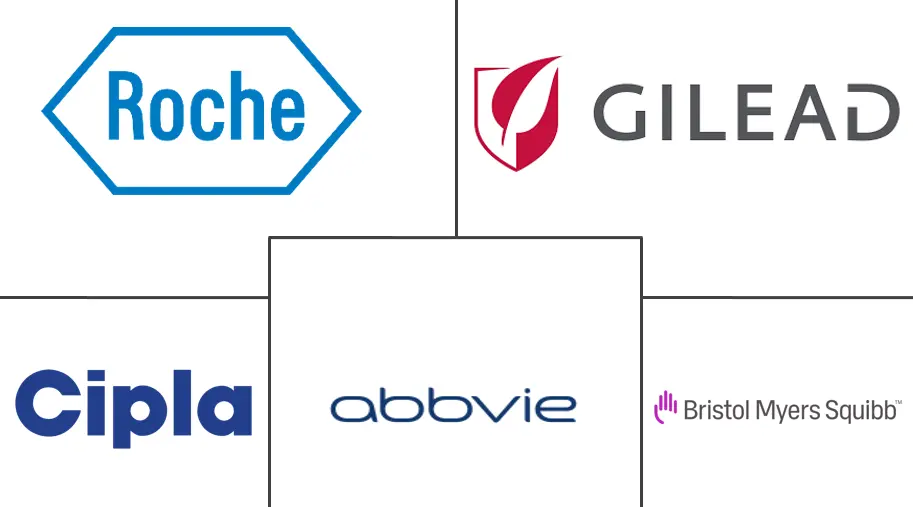Anti-Viral Therapeutics Market Size and Share
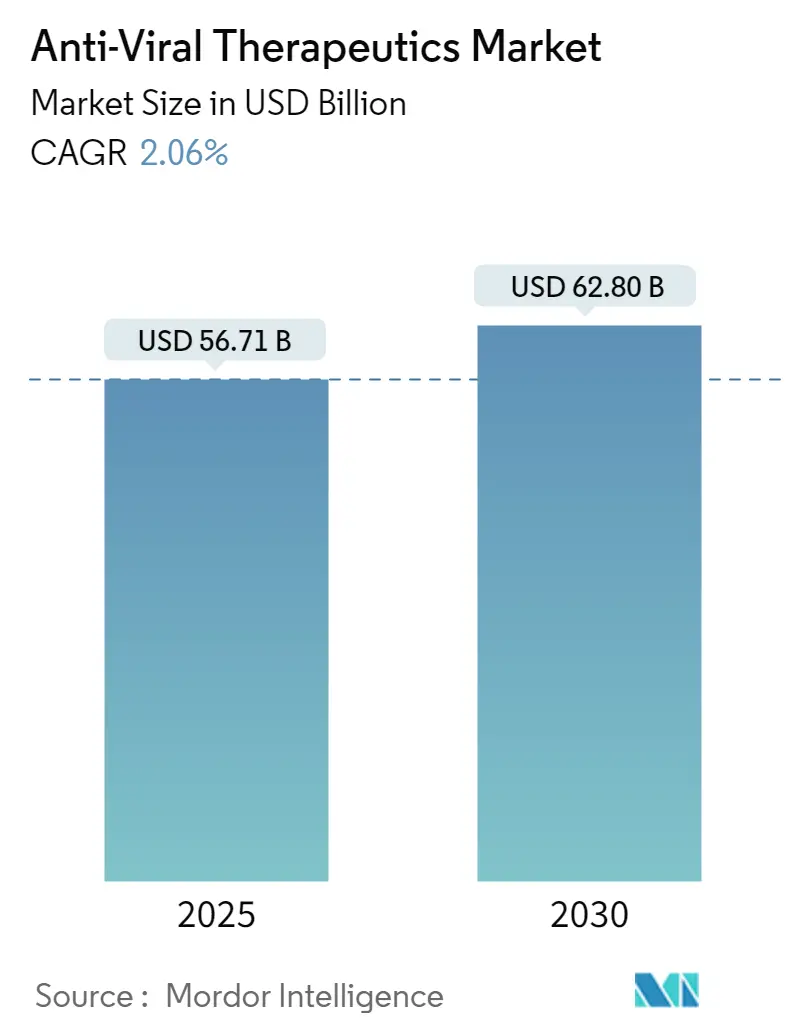
Anti-Viral Therapeutics Market Analysis by Mordor Intelligence
The Anti-Viral Therapeutics market size is USD 56.71 billion in 2025 and is forecast to reach USD 62.80 billion by 2030 at a 2.06% CAGR, highlighting a stable but opportunity-rich arena where legacy small molecules meet high-value delivery innovations. Long-acting formulations, AI-guided lead discovery, and government-backed broad-spectrum programs headline the current investment focus, while patent expiries on first-generation antivirals temper headline growth. Therapeutic developers are prioritizing real-world evidence packages to secure favorable reimbursement as price-control rules tighten in major economies. Competitive intensity remains moderate because scale players still dominate global distribution, yet differentiated biotech pipelines are attracting premium partnerships. The Anti-Viral Therapeutics market is also navigating supply-chain hardening, with cold-chain capacity expansions enabling wider access to biologics and long-acting injectables.
Key Report Takeaways
By virus type, influenza antivirals led with 46.29% revenue share in 2024; COVID-19/SARS-CoV-2 therapeutics is projected to expand at a 3.78% CAGR through 2030.
By drug class, reverse transcriptase inhibitors accounted for 33.94% of the Anti-Viral Therapeutics market share in 2024, whereas capsid inhibitors are forecast to grow at a 3.91% CAGR to 2030.
By route of administration, oral therapies commanded 64.28% share of the Anti-Viral Therapeutics market size in 2024, while topical formulations are advancing at 4.05% CAGR through 2030.
By geography, North America held 34.91% of 2024 revenue and Asia-Pacific is on track for the fastest 4.19% CAGR between 2025-2030.
Global Anti-Viral Therapeutics Market Trends and Insights
Driver Impact Analysis
| Driver | (~) % Impact on CAGR Forecast | Geographic Relevance | Impact Timeline |
|---|---|---|---|
| Expanding long-acting injectable pipelines | +0.8% | Global, with early adoption in North America & EU | Medium term (2-4 years) |
| Surge in HIV combination-therapy adoption | +0.6% | Global, concentrated in high-burden regions | Long term (≥ 4 years) |
| COVID-19-driven antiviral R&D spill-over | +0.4% | Global, with innovation hubs in North America, EU, Asia-Pacific | Short term (≤ 2 years) |
| AI-enabled nucleos(t)ide analog design | +0.3% | North America & EU core, spill-over to Asia-Pacific | Long term (≥ 4 years) |
| Public-sector funding for broad-spectrum agents | +0.2% | Global, government-led initiatives | Medium term (2-4 years) |
| mRNA platforms pivoting to antivirals | +0.1% | North America & EU, expanding to Asia-Pacific | Long term (≥ 4 years) |
Source: Mordor Intelligence
Expanding Long-Acting Injectable Pipelines
Twice-yearly lenacapavir entered the Anti-Viral Therapeutics market in 2025 and immediately reframed adherence expectations by reducing clinic visits, a key barrier in low-resource settings. Proprietary nanocrystal carriers maintain drug levels for up to six months, improving viral suppression persistence and cutting monitoring costs. Building on this proof point, Merck’s once-monthly oral MK-8527 flags a next wave where modified-release capsules rival injectables for convenience. Health-system capacity gains matter most in regions where over-burdened clinics hinder daily pill programs. Payers increasingly favor these regimens because fewer missed doses translate to lower progression-of-care costs. As manufacturing matures, pricing parity with daily orals is anticipated, accelerating global uptake beyond the early adopter markets that currently anchor volumes.
Surge in HIV Combination-Therapy Adoption
Clinical practice is pivoting from three-drug backbones toward dual or long-acting pairings that limit cumulative toxicity while sustaining undetectable viral loads . Co-formulations such as lenacapavir plus islatravir seek to lock in multi-mechanism coverage against resistance, and GSK-ViiV’s VH499/VH184 program echoes the same strategy in a novel target space. Regulators are rewarding these fixed-dose combinations with priority reviews because the adherence upside generates downstream public-health benefits. For pharmaceutical incumbents that face generic erosion on older protease inhibitors, next-generation combos deliver a defendable margin and extend brand lifecycles. The Anti-Viral Therapeutics market benefits from higher per-patient values, while patients see fewer pills and reduced drug–drug interaction risk as they age with comorbidities.
COVID-19-Driven Antiviral R&D Spill-Over
The pandemic compressed discovery timelines, validated surrogate endpoints, and scaled antiviral API capacity, all of which now spill over into other respiratory and systemic viral programs [1]Source: Shionogi & Co., “SCORPIO-PEP Phase 3 Trial: Ensitrelvir Is the First and Only COVID-19 Oral Antiviral To Demonstrate Prevention,” shionogi.com . Ensitrelvir’s 67% risk-reduction in post-exposure prophylaxis underlined the commercial case for preventive antivirals beyond vaccines. Protease-inhibitor screening platforms built for SARS-CoV-2 have been re-tooled for influenza and RSV, shortening hit-to-lead cycles. Regulatory authorities that fast-tracked COVID therapies maintain special pathways for future broad-spectrum agents, encouraging cross-portfolio asset recycling. Manufacturing plants originally designed for pandemic surge demand now offer lower marginal costs for new indications, giving developers a capex-light route to market. Collectively, these spill-overs raise the innovation baseline and lend the Anti-Viral Therapeutics market fresh momentum even as COVID-specific sales moderate.
AI-Enabled Nucleos(t)ide Analog Design
Machine-learning models trained on viral polymerase structures are cutting years from analog optimization by predicting binding affinity and metabolic liabilities in silico. Exscientia’s pipeline showcases how AI-directed iterations can identify compounds that retain potency across coronavirus, influenza, and paramyxovirus families, supporting the push for broad-spectrum coverage. Algorithmic resistance forecasting guides combination-therapy design, reducing the likelihood of early cross-resistance. The result is a data-rich dossier that impresses regulators and payers alike. Although upfront computational investment is high, cycle-time savings and lower clinical attrition more than offset costs, boosting return on R&D across the Anti-Viral Therapeutics industry.
Restraint Impact Analysis
| Restraint | (~) % Impact on CAGR Forecast | Geographic Relevance | Impact Timeline |
|---|---|---|---|
| Rising antiviral-resistance mutations | -0.4% | Global, with hotspots in high-burden regions | Medium term (2-4 years) |
| Price-control & reimbursement headwinds | -0.3% | Global, concentrated in developed markets | Short term (≤ 2 years) |
| Biosafety-grade manufacturing bottlenecks | -0.2% | Global, acute in emerging markets | Medium term (2-4 years) |
| Cold-chain gaps in low-income regions | -0.1% | Sub-Saharan Africa, South Asia, rural areas | Long term (≥ 4 years) |
Source: Mordor Intelligence
Rising Antiviral-Resistance Mutations
Next-generation sequencing now exposes minority resistance variants long before phenotypic failure, revealing a deeper threat pool to current standards of care [2]Source: Hannah Wang, “Practical Updates in Clinical Antiviral Resistance Testing,” Journal of Clinical Microbiology, journals.asm.org . Influenza neuraminidase and HIV integrase inhibitor classes are already seeing erosion, prompting cost-intensive post-marketing surveillance and rapid development of second-line regimens. Health systems face rising laboratory burdens, and payers brace for costlier salvage therapies. To buffer the Anti-Viral Therapeutics market from a resistance-driven slowdown, sponsors increasingly bundle combination protocols and resistance-monitoring kits into launch plans. Yet the arms race between viral mutation and drug innovation keeps margins under pressure.
Price-Control & Reimbursement Headwinds
Policy makers are ratcheting down on drug budgets, with the US Medicare negotiation mechanism and European reference pricing moving in parallel to curb outlays. Beyond list-price cuts, payers demand pharmacoeconomic evidence that demonstrates incremental benefit over cheaper generics. As COVID-19 emergency authorizations sunset, oral antivirals must clear stricter cost-effectiveness bars to secure broad coverage. Developers in the Anti-Viral Therapeutics market therefore front-load real-world data generation and risk-share contracts, but margins inevitably narrow, complicating capital allocation for early-stage assets.
Segment Analysis
By Virus Type: Influenza Dominance Faces Emerging Threats
Influenza antivirals delivered USD 26.2 billion in 2024, equal to 46.29% of the Anti-Viral Therapeutics market size, underscoring entrenched seasonal demand and clinical familiarity. Steady pipeline progress toward polymerase acidic (PA) and polymerase basic (PB2) inhibitors broadens therapeutic options and may counter neuraminidase resistance. Meanwhile, COVID-19/SARS-CoV-2 treatments, though originating from pandemic urgency, now post a 3.78% CAGR through 2030 as post-exposure prophylaxis gains favor, especially among immunocompromised cohorts. Mature hepatitis B and C segments plateau because cure or functional-cure regimens shorten treatment durations, yet remain sizeable given disease burden in Asia and Africa. Herpes therapies are benefiting from micro-needle patches and in-situ gel formulations that promise superior lesion control. RSV and CMV programs leverage monoclonal antibodies and small-molecule fusion inhibitors, with pediatric indications offering growth headroom.
The Anti-Viral Therapeutics market shifts from single-pathogen strategies to host-targeted or broad-spectrum agents poised for pandemic readiness. Such programs attract non-dilutive public funding and can bypass narrow epidemiological peaks. CMV assets still address niche transplant populations, leading to premium pricing but limited volumes. Future competitive landscapes will hinge on rapid outbreak response capacity and cross-family efficacy, redrawing the virus-type hierarchy over the forecast horizon.

Note: Segment shares of all individual segments available upon report purchase
By Drug Class: Traditional Mechanisms Meet Novel Targets
Reverse transcriptase inhibitors retained a 33.94% Anti-Viral Therapeutics market share in 2024, propelled by backbone status in HIV and hepatitis B therapy. Incremental chemical tweaks improve resistance barriers and renal profiles, sustaining relevance against generic incursion. Capsid inhibitors, fronted by lenacapavir, show a category-leading 3.91% CAGR and are reshaping dose-frequency expectations through twice-yearly administration. Protease inhibitors remain vital in acute COVID-19 management, while polymerase/nucleoside analogs hold cross-viral credibility but seek differentiation via inhalable and pediatric formulations.
RNAi and antisense modalities press into late-phase trials, yet face delivery challenges that temper near-term commercial impact. Broad-spectrum small molecules court government stockpile contracts, providing a hedge against unpredictable outbreaks. Companies with balanced portfolios across these mechanistic classes are best placed to ride out resistance cycles and pricing volatility. Over the next five years, the Anti-Viral Therapeutics market size attached to capsid-based and host-factor inhibitors could double as clinical validation and manufacturing scale converge.
By Route of Administration: Oral Convenience Drives Market Share
Oral products captured 64.28% of global revenue in 2024, equivalent to USD 36.5 billion of the Anti-Viral Therapeutics market size, thanks to outpatient feasibility and pandemic-era telehealth prescribing. Reformulations that decouple absorption from food intake are further widening candidacy. Injectable formulations, particularly long-acting intramuscular agents, defend adherence-sensitive HIV and hepatitis segments, with device innovations reducing injection-site discomfort. Topical antivirals grow fastest at 4.05% CAGR, supported by thermoresponsive gels and nanoparticle creams that localize high drug loads for herpes or respiratory mucosal infections.
Emergent inhalation and nasal routes aim to deliver prophylaxis directly to respiratory epithelium, offering rapid onset for pandemic response toolkits. Route selection is increasingly patient-segmented: chronic suppressive therapy looks to depot injectables; acute, self-limiting infections favor fast-acting orals; localized disease leans topical. This diversity supports parallel growth tracks that sustain the Anti-Viral Therapeutics market beyond one-size‐fits-all formularies.
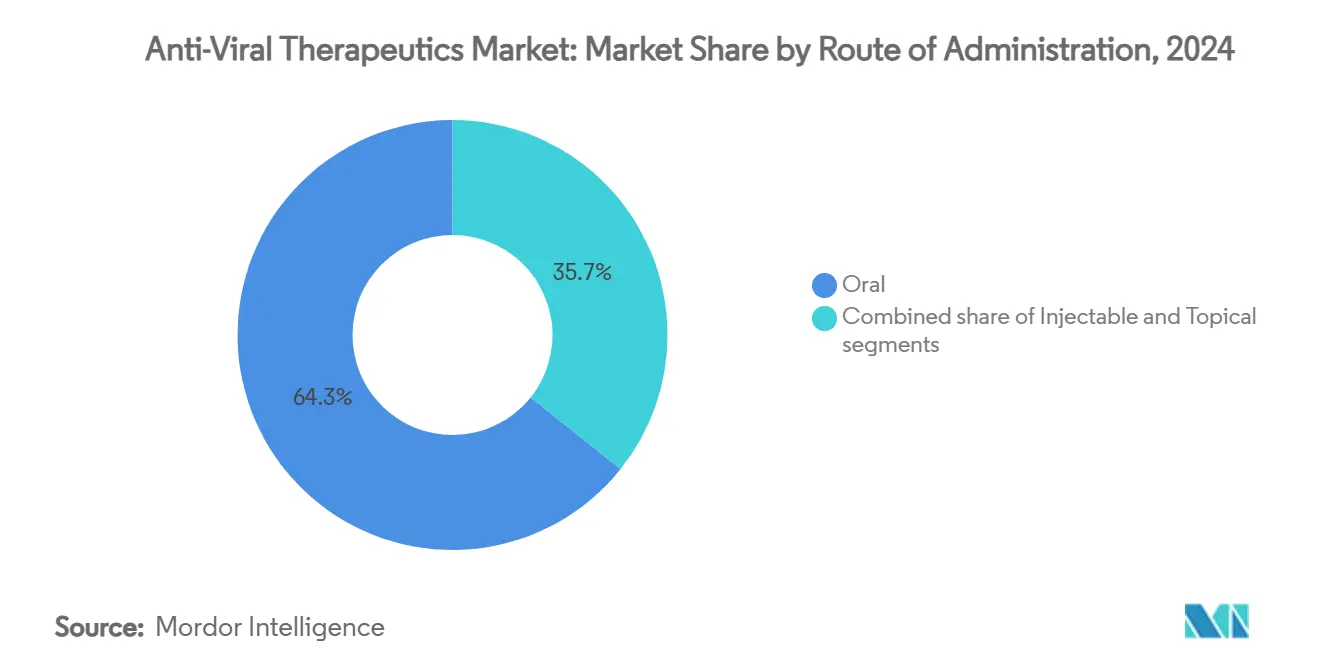
Note: Segment shares of all individual segments available upon report purchase
Geography Analysis
North America represented 34.91% of 2024 sales, buoyed by the FDA’s streamlined designations and deep payer wallets that reimburse premium antivirals. US-centric R&D hubs fast-track first-in-class assets, and integrated specialty-pharmacy logistics ensure prompt nationwide distribution. However, Medicare’s drug-price negotiations are set to pressure free-on-board prices, nudging firms toward value-based contracts that hinge on real-world virologic outcomes.
Asia-Pacific posts the fastest 4.19% CAGR as China, India, and Southeast Asia invest heavily in domestic pharmaceutical capacity and universal insurance schemes. China’s 2024 tally of 228 novel drug approvals signals regulator intent to match Western review speeds, drawing multinationals into local co-development partnerships. India leverages cost-optimized production to supply regional demand, and Japanese aging demographics support sustained antivirals usage for reactivated herpes zoster and RSV. Simultaneously, improving cold-chain frameworks unlock broader biologics access, further expanding the regional Anti-Viral Therapeutics market.
Europe maintains steady value but negotiates harder on price, using health technology assessments to enforce cost-effectiveness thresholds. EMA’s centralized procedure remains attractive for simultaneous bloc entry, yet post-Brexit dual filings add complexity. Southern and Eastern European nations, supported by EU healthcare restructuring funds, offer incremental volume upside as vaccine and antiviral awareness climbs. Collectively, geographic diversification spreads revenue risk but raises compliance costs, making global regulatory mastery a core competence for sector leaders.
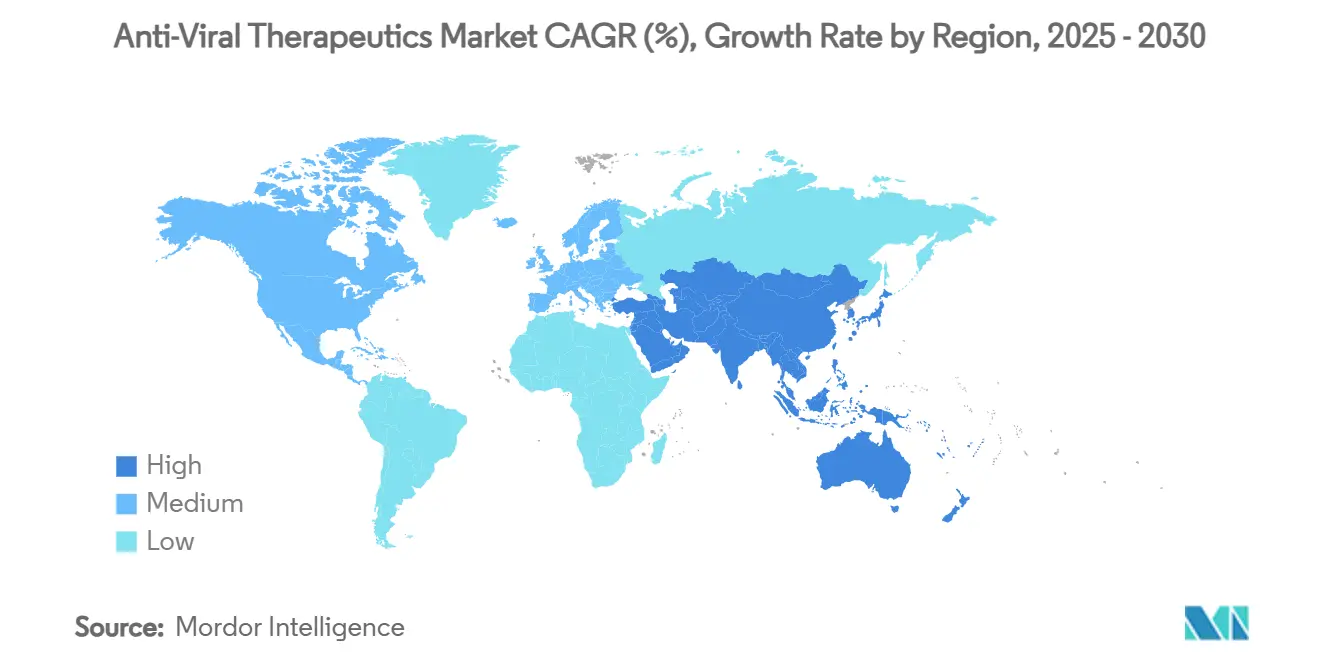
Competitive Landscape
The Anti-Viral Therapeutics market is moderately concentrated, with the top five players controlling significant but not overwhelming share; Gilead, GSK-ViiV, and Merck headline the incumbents. Their edge lies in global commercialization machinery and multi-mechanism portfolios that cushion against single-asset setbacks. Partnership deals have intensified: Merck pairs its islatravir pipeline with Gilead’s lenacapavir to craft a once-monthly oral prevention regimen, while Pfizer’s USD 525 million buyout of ReViral fortifies its RSV ambitions. Such moves blend big-pharma balance sheets with biotech agility, accelerating late-stage progressions and filling mechanism gaps.
Biotech challengers wield AI discovery, RNA-based mechanisms, and novel delivery devices to carve niches. Exscientia’s machine-learning pipeline has already attracted Gates Foundation backing, underscoring the growing synergy between philanthropy and commercial R&D. Meanwhile, digital-health adjuncts—adherence apps, home diagnostics—are becoming standard accessories in new product launches to satisfy payer evidence demands. In manufacturing, leaders are fortifying supply chains with dual-source API contracts and regional fill-finish sites, lessons hard-learned from pandemic disruptions.
Future competitive advantage will revolve around resistance-monitoring ecosystems, cost-effective long-acting formulations, and ability to navigate multi-jurisdiction pricing audits. Companies failing to demonstrate clear real-world value risk formulary exclusion despite regulatory approvals, especially in Europe and an increasingly cost-conscious United States.
Anti-Viral Therapeutics Industry Leaders
-
AbbVie Inc.
-
Bristol-Myers Squibb Company
-
Gilead Sciences Inc.
-
F. Hoffman-La Roche Ltd
-
Cipla Inc.
- *Disclaimer: Major Players sorted in no particular order
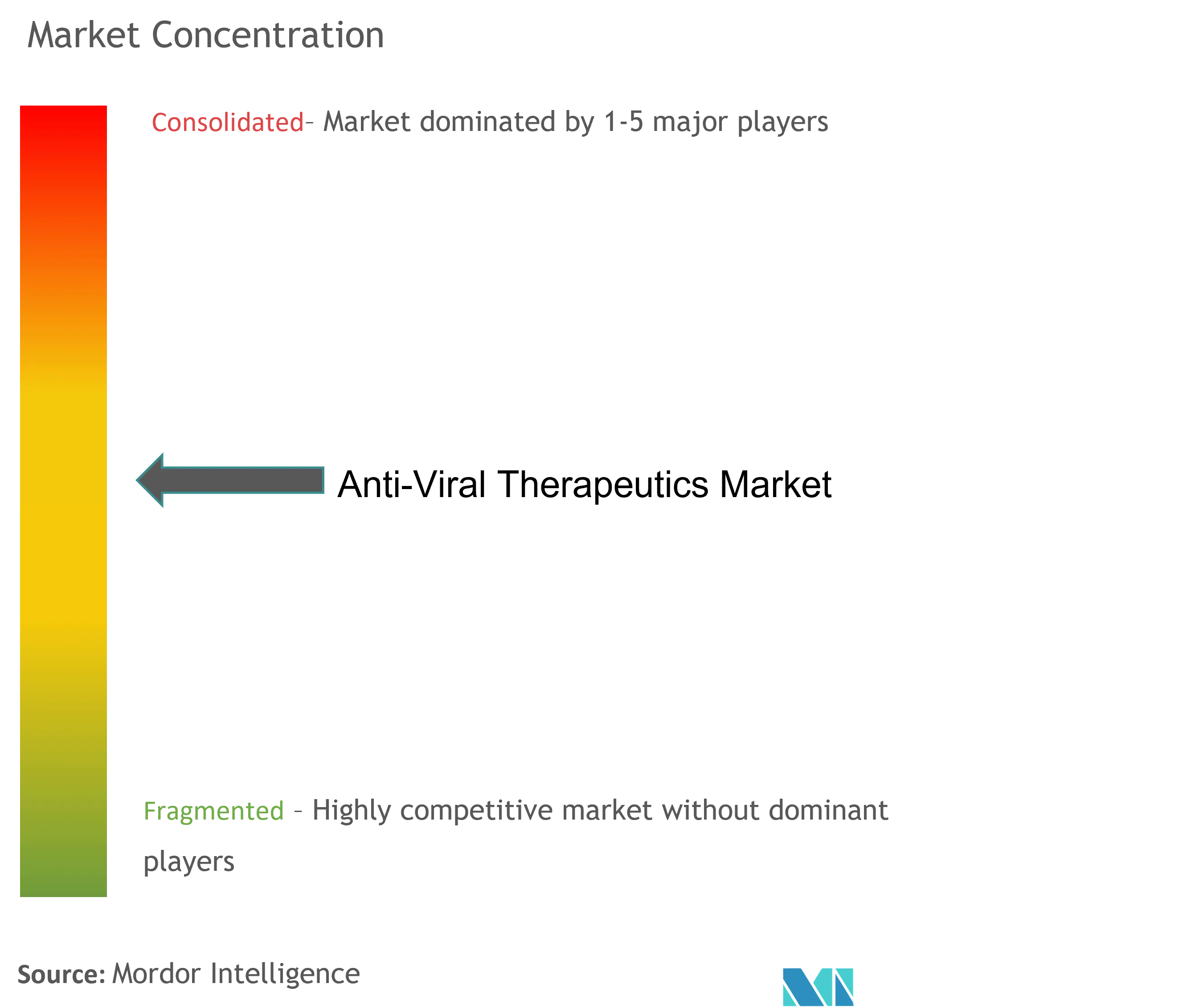
Recent Industry Developments
- March 2025: Shionogi announced Phase 3 SCORPIO-PEP results showing a 67% COVID-19 risk reduction from ensitrelvir post-exposure prophylaxis. FDA granted Fast Track status
- March 2025: Gilead and GSK-ViiV advanced once-yearly lenacapavir and VH499/VH184 HIV prevention programs into Phase III after favorable Phase I data
Global Anti-Viral Therapeutics Market Report Scope
Anti-viral drugs are a class of medication used for treating viral infections. While a broad-spectrum antiviral is effective against many viruses, most antivirals target specific viruses.
Anti-viral Therapeutics Market is Segmented by Drug Type (Herpes Anti-viral Drugs, Hepatitis Anti-viral Drugs, HIV Anti-viral Drugs, Influenza Anti-viral Drugs, and Other Anti-viral Drugs), Distribution Channel (Hospital Pharmacy, Independent Pharmacy, and Drug Store, Online Pharmacy), and Geography (North America (United States, Canada, and Mexico), Europe ) Germany, United Kingdom, France, Italy, Spain, and Rest of Europe), Asia-Pacific (China, Japan, India, Australia, South Korea, and Rest of Asia-Pacific), Middle East and Africa (GCC, South Africa, and the Rest of Middle East and Africa), and South America Brazil, Argentina, and Rest of South America)). The report also covers the estimated market sizes and trends for 17 countries across major regions globally. The report offers value (in USD billion) for the above segments.
| By Virus Type | HIV & AIDS | ||
| Hepatitis B | |||
| Hepatitis C | |||
| Influenza | |||
| Herpes (HSV) | |||
| Respiratory Syncytial Virus (RSV) | |||
| Cytomegalovirus (CMV) | |||
| Other & Emerging Viruses | |||
| By Drug Class / Mechanism | Reverse Transcriptase Inhibitors (NRTI/NNRTI) | ||
| Protease Inhibitors | |||
| Polymerase / Nucleoside Analog Inhibitors | |||
| RNAi & Antisense Therapeutics | |||
| Broad-spectrum Small-molecule Antivirals | |||
| Capsid Inhibitors | |||
| Others | |||
| By Route of Administration | Oral | ||
| Injectable (incl. Long-Acting) | |||
| Topical | |||
| Others | |||
| By Region | North America | United States | |
| Canada | |||
| Mexico | |||
| Europe | Germany | ||
| United Kingdom | |||
| France | |||
| Italy | |||
| Spain | |||
| Rest of Europe | |||
| Asia-Pacific | China | ||
| India | |||
| Japan | |||
| South Korea | |||
| Australia | |||
| Rest of Asia-Pacific | |||
| South America | Brazil | ||
| Argentina | |||
| Rest of South America | |||
| Middle East and Africa | GCC | ||
| South Africa | |||
| Rest of Middle East and Africa | |||
| HIV & AIDS |
| Hepatitis B |
| Hepatitis C |
| Influenza |
| Herpes (HSV) |
| Respiratory Syncytial Virus (RSV) |
| Cytomegalovirus (CMV) |
| Other & Emerging Viruses |
| Reverse Transcriptase Inhibitors (NRTI/NNRTI) |
| Protease Inhibitors |
| Polymerase / Nucleoside Analog Inhibitors |
| RNAi & Antisense Therapeutics |
| Broad-spectrum Small-molecule Antivirals |
| Capsid Inhibitors |
| Others |
| Oral |
| Injectable (incl. Long-Acting) |
| Topical |
| Others |
| North America | United States |
| Canada | |
| Mexico | |
| Europe | Germany |
| United Kingdom | |
| France | |
| Italy | |
| Spain | |
| Rest of Europe | |
| Asia-Pacific | China |
| India | |
| Japan | |
| South Korea | |
| Australia | |
| Rest of Asia-Pacific | |
| South America | Brazil |
| Argentina | |
| Rest of South America | |
| Middle East and Africa | GCC |
| South Africa | |
| Rest of Middle East and Africa |
Key Questions Answered in the Report
1. What is the current Anti-Viral Therapeutics market size and growth outlook?
The Anti-Viral Therapeutics market size is USD 56.71 billion in 2025 and is projected to reach USD 62.80 billion by 2030 at a 2.06% CAGR.
2. Which virus segment leads the Anti-Viral Therapeutics market?
Influenza antivirals hold the lead with a 46.29% revenue share in 2024.
3. Which region is growing fastest for antiviral sales?
Asia-Pacific shows the highest regional CAGR at 4.19% through 2030, driven by expanded healthcare access and local manufacturing scale-up.
4. What drug class is expanding quickest within the market?
Capsid inhibitors post the fastest 3.91% CAGR thanks to long-acting products like lenacapavir.
Page last updated on: July 21, 2025
